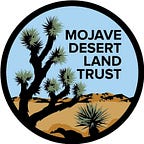Dark sky data revealed for Mojave Trails National Monument
The dark night sky is being mapped in the monument thanks to an MDLT project promoting women in STEM.
In February 2021, MDLT’s Dark Night Sky Measurement Project finished a six-month long survey of the night sky quality in the western portion of Mojave Trails National Monument (MTNM). Using both a Sky Quality Meter — or SQM — and Dark Sky Meter (DSM) phone app, three Women In Science Discovering Our Mojave (WISDOM) interns were able to contribute vital scientific research in the monument.
We used an International Dark Sky Association (IDA) recommended SQM reader to take the official readings of sky quality. Zenith, temperature, weather, and visibility are also recorded. GPS points are taken at each of the eight locations. Interns recorded four measurements using the SQM reader to create an average at each location.
Interns used smartphones with the Dark Sky Meter app to record the same data. This data is then submitted via the apps to three different citizen science projects that track global night sky pollution, the primary project being Globe at Night. This project is the largest global nighttime community citizen science project and aims to raise public awareness of the impact that light pollution has on energy consumption, wildlife habitat, and human health. This project also aims to gather long-term data reflecting changes in night sky pollution. The global community, governments, and scientists can use the compiled data to make decisions about lowering light pollution, eco-friendly city lighting, conservation planning, and tracking animal habits (like bat movements).
According to Globeatnight.org, citizen scientists were able to submit 10,000 data points from 71 countries and all 50 US states. By looking at the interactive map, you can see how city encroachment affects our wild spaces and how we can plan conservations measures. It also gives visitors ways to interact with both the land and sky to find dark night places to visit.
Overall, the 6-month long study revealed that encroachment of light pollution from both Los Angeles and Las Vegas is starting to impact the quality of the night sky in Mojave Trails National Monument. As man-made air pollution increases and lingers, the encroaching light is reflected more in the night sky, creating brighter location points within the monument.
However, most of the study’s measurement points have revealed that the western portion of the monument continues to remain a great dark night viewing area.
At 21.24 lumens, the ghost town of Siberia has the highest reading. A former water station for the Santa Fe Railroad, Siberia was once a pit-stop for people driving on Route 66 between Needles and Barstow, until it was superseded by the introduction of Interstate 40 in 1973. Sheephole Pass, one of the entry points to the national monument, had the lowest reading.
The research conducted by the WISDOM internship will assist the Bureau of Land Management’s Mojave Trails National Monument in its effort to work toward International Dark Sky support.
Dark sky recognition can help protect the broad views and vistas, flora and fauna, and the recreating community of Mojave Trails National Monument.
Together we can start putting conservation measures in place to keep it that way. We can view the Milky Way and other celestial bodies from many places in the monument.
Although Afton Canyon Campground is the only officially developed campground in the monument, it has a night sky average just slightly lower than that of Siberia, thereby making it a perfect destination for night sky viewing.
If you go out to visit the monument, remember to follow all outdoor ethics. Information on dispersed camping or campground information (like in Afton Canyon), fire restrictions, and how to acquire a fire permit can all be found by visiting the Bureau of Land Management’s official website listed below.
Next steps
During the project, we uploaded information and data points to the various Citizen Science projects. Our data is readily available to the scientific community, planners, conservationists, and the global community as a collective whole.
We will continue to upload data to these projects as the internship moves forward. Our blogs, presentations, and media posts are meant to help drive the movement for night sky conservation, and we will continue to provide these public service announcements. Additionally, our raw and synthesized data has been supplied to the Bureau of Land Management. They can use this information when making future decisions for management of the monument. We will also be able to assist the Bureau of Land Management, by supplying data and narrative in a Dark Sky Sanctuary application.
Get involved
For the Night Sky project, we are participating in the Globe at Night and Loss of the Night citizen science programs. Why not join in? Our collective information can help our global community study light pollution around the world. For more advice on becoming a citizen science, watch our video.
https://www.blm.gov/visit/mojave-trails-national-monument
https://www.readyforwildfire.org/permits/campfire-permit/
Women in Science Discovering Our Mojave (WISDOM) is an MDLT internship program in collaboration the Bureau of Land Management that seeks to help engage women from underserved communities studying Science, Technology, Engineering, and Math (STEM).
The WISDOM internship program is made possible through funding from Southern California Edison International.
